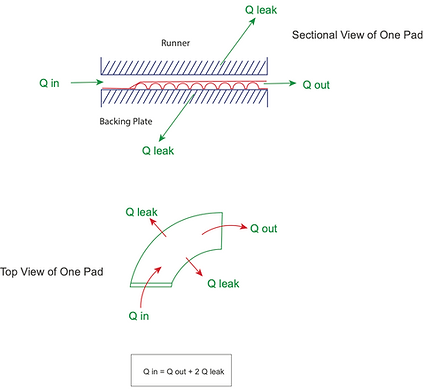Folie luchtlager ontwerp en installatiegids
Folie Stuwkracht Luchtlager
De basisplaat, het lagerhuis, het OAV-stuwluchtlager en alle bijbehorende onderdelen mogen alleen met isopropylalcohol worden gereinigd om onzuiverheden en stofdeeltjes te verwijderen.

Het OAV Foil Thrust Air Bearing wordt vervolgens met een lichte perspassing op de paspennen van de basisplaat geperst om het lager stevig op zijn plaats te monteren.



Ontwerp- en installatiehandleidingen
Het OAV Foil Thrust Air Bearing wordt vervolgens met een lichte perspassing op de paspennen van de basisplaat geperst om het lager stevig op zijn plaats te monteren.

Om stuwkrachtomkering te voorkomen, wordt aanbevolen om indien mogelijk twee foliedruklagers (1 CW + 1 CCW) aan elke kant van de Runner (drukschijf) te gebruiken.
CW- en CWW-richtingen hieronder weergegeven.


Foil Thrust Air Bearing Flow Dynamics

Figure 1: Foil bearings are self-acting; the hydrodynamic gas film forms with speed—no external pressurization is required for operation.
Folie Journal Luchtlager
OAV-luchtlagers met folielagers hebben een nauwkeurige buitendiameter en moeten indien nodig in de behuizing worden aangebracht. Als de basisplaat moet worden gebruikt, gebruik dan paspennen, schroeven met schroefdraad of beide zoals weergegeven in de onderstaande afbeelding om de lagers met een lichte perspassing vast te zetten.
De basisplaat, het lagerhuis en het OAV-luchtlager met folielagers en alle bijbehorende onderdelen mogen uitsluitend worden gereinigd met isopropylalcohol om onzuiverheden en stofdeeltjes te verwijderen.





Het OAV-luchtlager met folielager kan ook op het lagerhuis worden gemonteerd, waarbij een overgangspassing tussen de twee componenten behouden blijft.

CW- en CWW-oriëntatie hieronder weergegeven.

Foil Journal Air Bearing Flow Dynamics
